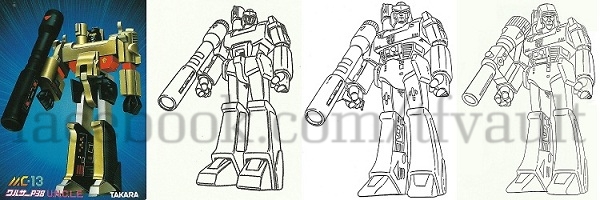
This is a piece that I've had on the backburner now for more than 1ฝ years. Originally intended as a short article for the eventually cancelled Auto Assembly Europe 2012 convention magazine, the article just grew and grew and would have taken up most of the magazine, being almost 20 pages long! So I decided it probably wasn't the best place to have it. I've been trying to find another suited venue for it ever since and am now presenting it here in (initially) 2 installments. There is a LOT of additional material for this subject that I'd like to present as well, but I haven't had the time to write that yet. So for now I would like to present to you part 1 of a look at some of the earliest original designs for the Transformers toy line.
Introduction
When designing a Transformers toy a practice used from before Transformers came to be and still used even in today's computer aided era a lot of different ideas are examined through a number of hand-drawn sketches and drawings. These design sketches usually go through many changes and revisions before the final design that will define the character needed is settled upon.
With the very first Transformers character models being based on already existing toys, a lot of artwork could be reused straight from the Micro Change and Diaclone lines. While some had little to no changes made, save for the addition of a faction symbol, others needed heavy alterations for animation use. Takara artist Shōhei Kohara created the character models for the earliest animated Transformers commercials before artist Floro Dery who would later design all the 1986 Movie characters simplified and optimized those models further for the weekly TV show.
Many of the early characters models were heavily modified in order to make them more anthropomorphic in contrast to their otherwise perhaps too robotic looks characters like Ironhide, Ratchet, Huffer and Brawn bore little resemblance to their toy counterparts to name a few of the most famous examples.
Some elements in the character models however did not stem from trying to evoke more human-like qualities in the robots' appearance, but would seem to stem from which source material the artists had to work from.

Looking at the various stages of the character model development, it becomes clear where some of the most striking design cues for Megatron originate: The over-the-shoulder barrel, the protruding abdomen based on the folded-up trigger, the receded neck line, the heel "spurs" and the hip plates all seem to have come from the earliest Micro Change toy mockup, while the revised gun/scope design and attachment as well as the classic bucket helmet of the final model seem like very late additions and are clearly based on the actual toy; not shown, but even the red elbows and the red sides of the Micro Change artwork were kept for the final character model's color scheme, although the released toy never had these colors.
"Diaclone: Jizai Gattai"
By late 1984 Hasbro knew that they had struck gold with these extraterrestrial mechanoids with personalities and needed to expand the ranks to keep the kids and the suppliers happy. The 1985 toy line-up was as an extension of what was done for the original 1984 line-up again based on pre-existing designs pulled from various existing Japanese toy lines.
By 1985 that pool of pre-existing designs they could pull from was all but exhausted which led to Hasbro and Takara beginning to design all-new toys for the 1986 Movie line-up. Still, a few left-over and unused designs from Takara's archives could be put to good use for the intended pre-Movie 1986 line-up.
Takara's Diaclone toy line had originally continued on a while in Japan even after the US Transformers debut in 1984, and having already started experimenting with a smaller scale earlier in Diaclone designs like the pre-Constructicons, who neither had nor could fit the little Diaclone drivers Takara had originally made further plans with this even smaller scale.
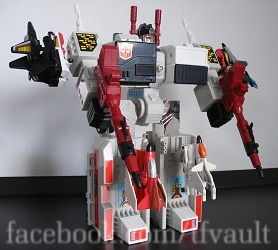
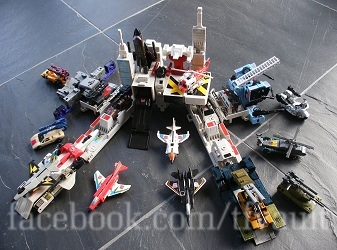
Perhaps due to the popularity of the combination element at the time, both within Diaclone and Micro Change, Takara started work on the next batch of toys for Diaclone, which they would have given the sub-line name of "Jizai Gattai" or in English, "Free Combination".
The toys on the drawing board for "Jizai Gattai" included what would later become the Aerialbots, the Stunticons, the Protectobots, the Combaticons and Metroplex. These toys are interchangeable between themselves and compatible with Metroplex, as all the smaller team members can attach to him in robot mode, while the four leaders in their 3rd modes can attach to Metroplex's city mode. Takara kept the idea of giving all these toys they own "subline" within the Transformers, as all these became known as being part of the "Scramble City" imprint in Japan.
The Transformers Cartoon Show Bible
Every cartoon has a show bible a testament of what the concept of the series is, the characters that appear in it and the episodes intended for each season and their plots. Usually kept in a binder by key personnel on the show, the show bible is easy to update with new or updated material, as each page is easily replaced in the binder. The Transformers show bible included with the Fun Factory DVDs from 2009 only contained information on season 1. By the August 9, 1986 revision, a lot of sections had been added and expanded upon, most notably the character sheets for both the 1985 toys and the pre-movie 1986 toys.
Perhaps due to time constraints in regards to production of both the toys and the animated cartoon (a half-hour episode literally takes months to produce, as does a toy), the 1986 combiners are not shown with their animated character models, but rather with an interesting mix of design sketches and traced drawings of the actual toys, providing a rare insight into the design process.
The Aerialbots
Since each page in the bible could easily be replaced by an updated image at any given time, there might be newer and more complete images for some of these characters, while others look very early and very rough all depending on how up-to-date the bible owner chose to keep his copy. The Aerialbots may well have been the first team to be fully developed, as the show bible includes pretty much finished images of all four of the smaller members.
Looking at the entries for the Aerialbots, the 4 smaller members Slingshot, Fireflight, Skydive and Air Raid are all depicted as the example seen with Slingshot: A (somewhat shaky) line tracing of the finalized toy design. Why exactly this depiction has been chosen is a good guess, especially given how easy a page and image can be replaced in the show bible, but perhaps photos of the actual toys would not translate well through a fax machine or photocopier; shipping over photos by mail from Japan may have taken too long, and color photocopying was still an expensive tool back in the mid-1980s.
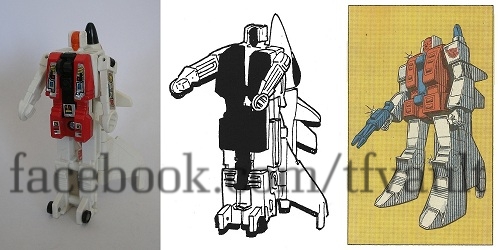
Even coloring seems to have been finalized as and again using Slingshot as an example because his bright colors and all the images in the show bible being at least 2nd generation photocopies the images match the final production toys very much, even with the squiggly lines and the blurry details. It is very possible that these toys were very far along in their life cycle as "Jizai Gattai" toys (as compared to some of the later entries in this article), also considering what has been seen until now of other pre-production images of the combiners.
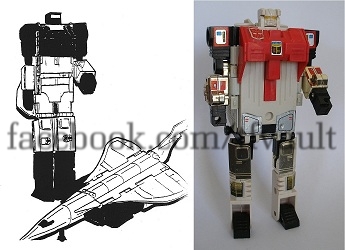
The odd elements in the Aerialbot entries are Silverbolt and Superion. Silverbolt looks almost like his production toy, but there are a few subtle differences. First off, his head is very square. True, the final toy's head is basically still a square, but looking at the coloring in the design drawing, it would seem that the entire head was originally meant to be a dark color, where the white stripe is a possible indication of where the eyes would be. Also, the rear landing gear wheels are seen on the front of his thighs, as opposed to on the sides pointing backwards on the final toy, which might have been a change to better support Silverbolt's 3rd launcher mode.
Looking at a pre-production mockup of the final combined mode, Superion, we find that a lot of design elements are present between the design sketch Silverbolt and the torso-mode combined Silverbolt:
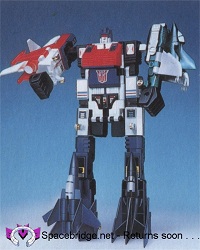
Both images contain the dark lower legs, the wheels on the front of the thighs, the "diaper" design of the pelvic area and the abdominal plate for the Autobot emblem. All the basic elements for what would become the Superion toy are also present (besides the colors and stickers) only missing the add-on chest plates, the head piece and the foot plates.
It is very interesting to see how self-contained the combined mode was intended to be: The two leg planes, Fireflight (in black) and Air Raid (in blue) are facing the other way and are as such able to act as feet without added parts. Skydive (in red) and Slingshot (in blue) have the added fists, though ("borrowed" for this concept image from the pre-Transformers Raiden toy, no less). The head seems to be an integrated part of the toy, which was also abandoned. This depiction of Superion was possibly very close to seing production as it was, as it was even used in this Takara promotional art piece:
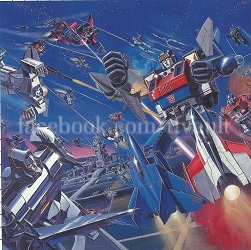
The head is slightly different and the colors on the smaller planes are a bit different, while the arms are upside-down, but the fuselage-on-front legs design would hang on for a while still.
Looking at the next image used for Show Bible Superion, we find that the legs are still facing forward and the thigh-wheels are still present, but now we have dedicated foot plates and chest armor as we know it plus a new separate head piece that looks much more familiar.
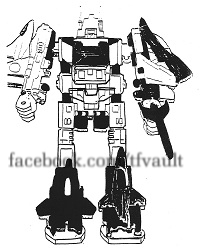
Upon closer examination, though, it would seem that the super mode head is drawn directly onto the image of Silverbolt's own head (as do the foot plates) even with the inherent shakiness of tracing a photo like this, this seems exceedingly free-hand. It is not hard to imagine that this image was the basis for what became the final design for cartoon and comic book Superion's head, where Silverbolt's highly stylized face could easily be interpreted as representing a faceplate and a visor on the larger head.
While the larger head is less integrated into the toy, the smaller original Superion head (as seen on the concept image earlier) would not have had the same visual impact, and was frankly a bit out of scale. But why the changes were made in the first place and if the show bible's hand-drawn head is indeed the basis for his character model we may never know for certain.

NEXT TIME: Join us again next time for the second - and for now - final part of this article, when we examine the origin of the Stunticons! :) [ Link to part 2 ]
Sources:
Special thanks go out to the following individuals:
|
Notes - July 23, 2021
This article was first published on the NTFA message board as episode 12 of "From The Vault", and then archived when the message board was closed down in 2018. Return to main page here. Facebook page: From The Vault - TF Showcase |